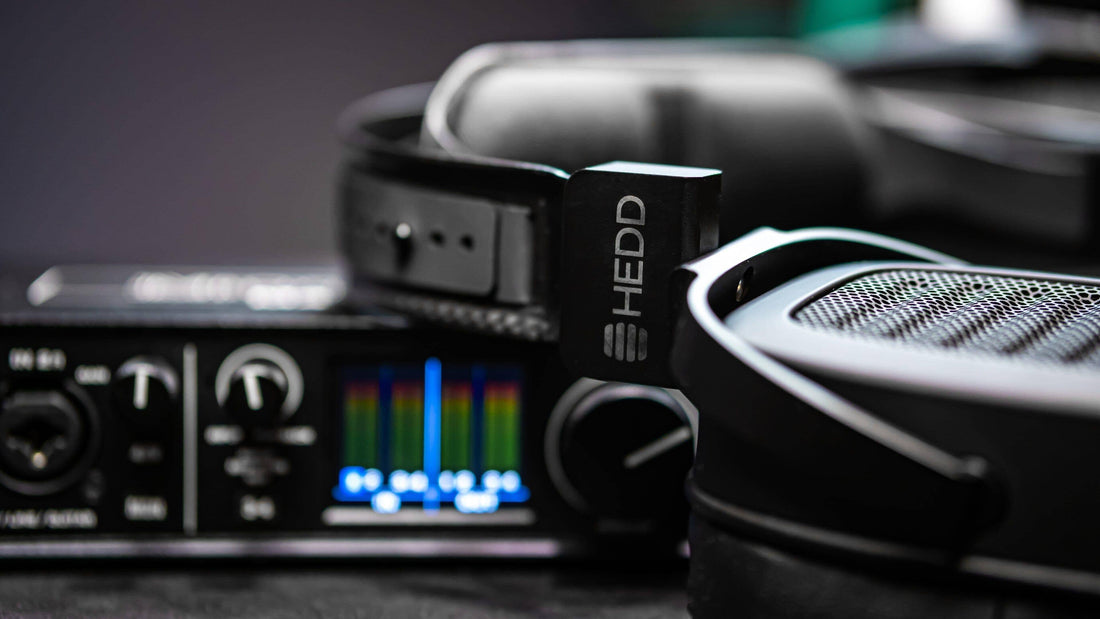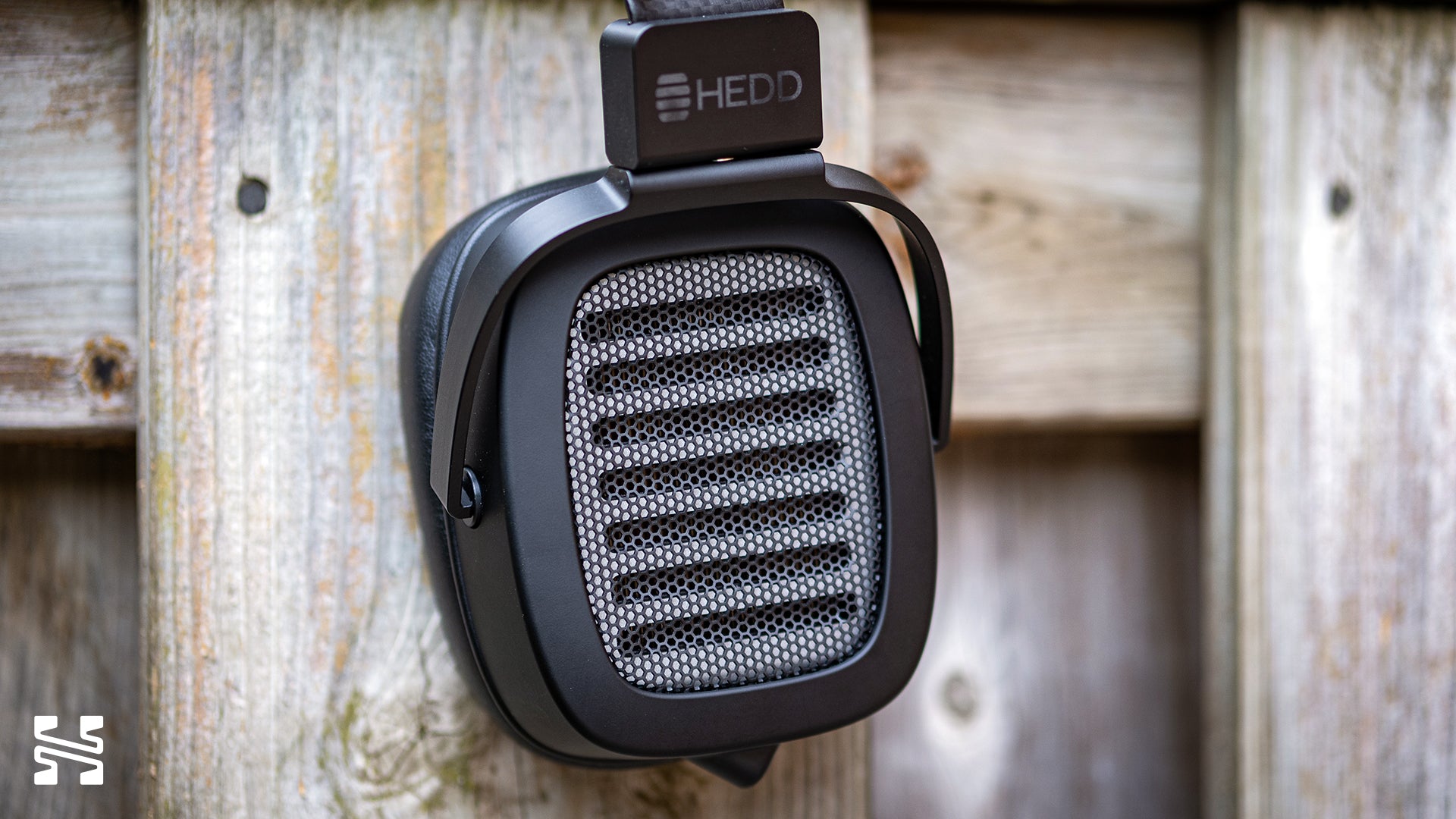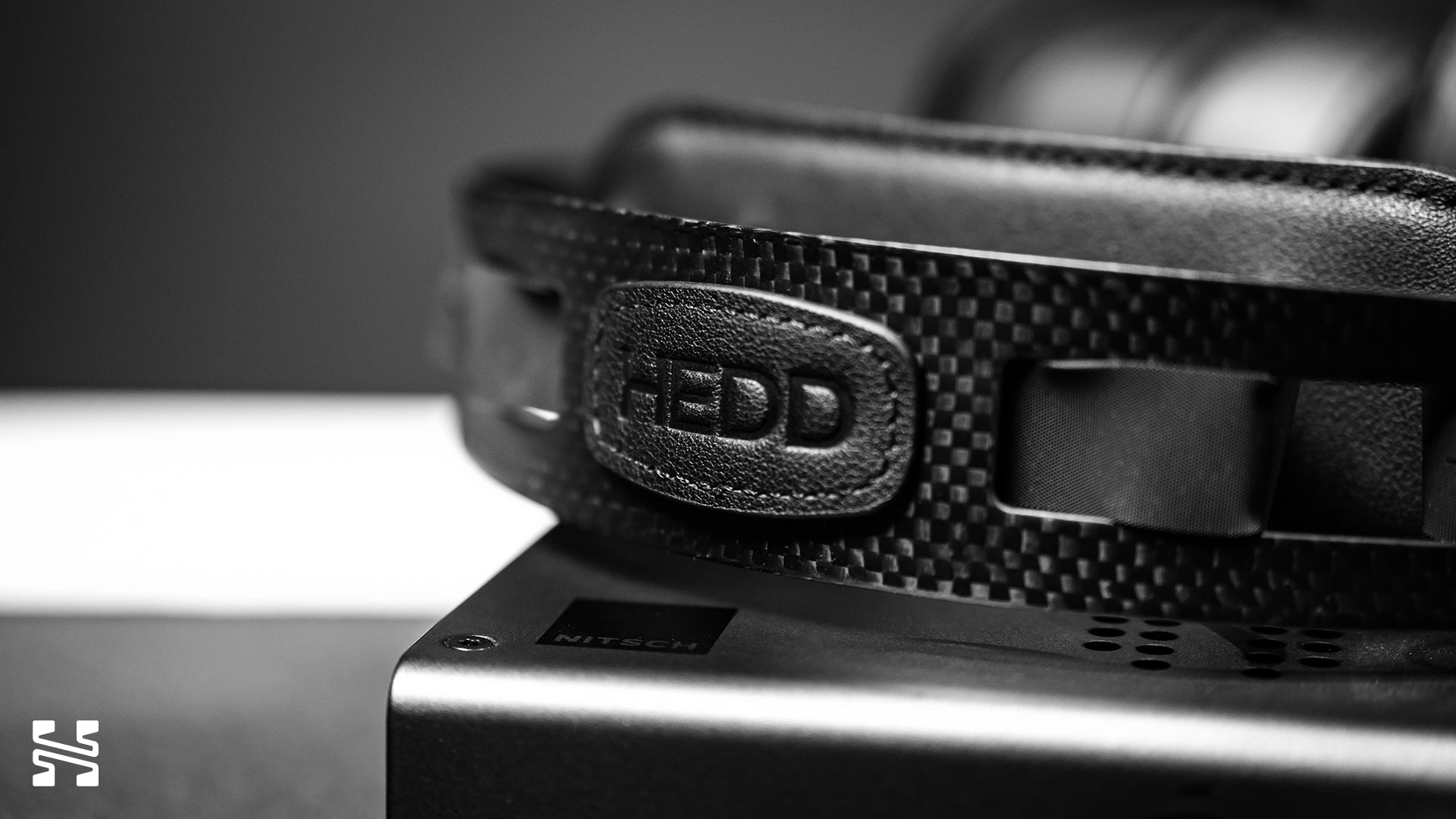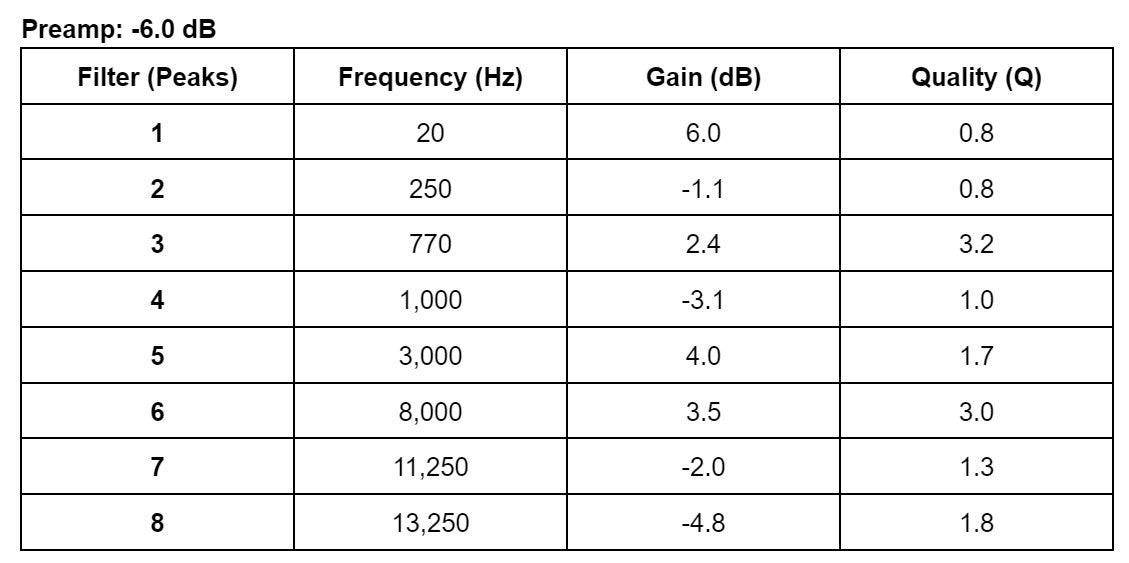HEDDPhone TWO Review: I've Never Been so Excited for a Headphone

Introduction
Headphones generally come in two flavors: dynamic drivers and planar magnetics. While there are more exotic topologies like electrostatics or ribbon drivers, the requirement of even more specialized equipment to power them have created a significant barrier to entry. So when the original HEDDPhone was released back in 2018 using AMT drivers, I was very interested.
HEDD Audio pioneers a unique driver technology called an Air Motion Transformer (AMT). It’s an electrodynamic driver that “folds” air to squeeze it out at four times the speed. Their words, not mine. While AMT drivers have been around in the speaker space for quite a while, they were typically limited to the higher frequencies. However, it was in the original HEDDphone that HEDD Audio pioneered the Variable Velocity Transformation (VVT) technology that finally allowed these AMT drivers to be fashioned for full-range performance. And it does so without the need for dedicated amplifiers.
While the original HEDDPhone was fairly well received, it didn’t gather much of a following. A major hurdle to its success was its ergonomics - it was a heavy, industrial headphone that didn’t fit too many heads nicely. Well, that feedback was noted. Enter the $2,000 HEDDPhone TWO. Representing HEDD Audio’s second attempt at the headphone market, they’ve re-designed the HEDDPhone from the ground-up to bring their AMT technology to the widest audience possible. It’s no exaggeration for me to say that this is the headphone I’ve been looking forward to the most in 2023. Let’s see if it lives up to expectations.
Source(s): Ferrum Audio ERCO Balanced DAC/amp
Note: I haven’t heard the original HEDDPhone for long enough to give a proper comparison. Here are my quick impressions when I demo’d it if you’re curious.
HEDD Audio HEDDPhone® Two
$1,999.00
What we like
- Excellent ergonomics and build quality
- Sense of “speed” and microdetail
- Outstanding timbral resolution and microdynamic control
What we don’t like
- A little heavy
- Bright and sibilant in the upper treble
- Lack of macrodynamic slam in the bass
What’s in the Box?
Unlike the original, the HEDDPhone TWO uses 3.5 mm inputs on each side and its cups now swivel 90 degrees. Its pads are a thick plush pleather and while they’re noticeably smaller than their predecessor, they’re around the average size for a normal headphone. I don’t have the final retail packaging but these are the accessories you can expect:
- A carrying case molded for the HEDDPhone TWO’s design with an ingenious little compartment to carry its stock cable.
- A spare set of ear pads. A very nice inclusion that I wish was standard among all high-end manufacturers.
- Two 2.2m fabric-sleeved headphone cables: unbalanced 6.35 mm and balanced 4.4 mm.
- Two adapters: unbalanced 6.35 mm to 3.5mm and balanced 4.4 mm to XLR.

The HEDDPhone TWO is built for practicality. Its re-designed drivers are smaller and lighter than its predecessor’s. The cups and yokes are made out of magnesium while its headband is carbon fiber. With these materials, HEDD Audio was able to reduce the weight of the HEDDPhone TWO by 25% of the original, down to a relatively more comfortable 550 g. While this may still seem hefty, I actually found the HEDDPhone TWO to be more comfortable than the Audeze MM-500 that I recently reviewed despite weighing 50 g more. I was easily able to have it on for hours at a time.
The secret to its comfort is the new patent-pending HEDDband system that HEDD Audio has engineered. The suspension strap has two straps: one to adjust height and the other to adjust clamp force. Altogether, it does an amazing job of distributing the weight of the headphone and pressure spots are further alleviated with dense memory foam padding on the strap. Frankly, I’m surprised that it took this long for someone to create a headband this good. Of course, it doesn’t defy the laws of gravity; there is still an appreciable weight on my head. But it feels very manageable and allows a healthy range of motion without slipping around.

There is one small note I want to make in case anyone runs into the same thing and is concerned. If you’re wearing the HEDDPhone TWO and push the pads against your head, you will hear a crinkling sound as the drivers reset to their original position. It doesn’t hurt the drivers and is a result of air displacement. Plus, the HEDDPhone TWO comes with a 5-year warranty so you can be sure that HEDD Audio is confident with what they have here. Obviously, don’t purposefully do it. It’s not the most pleasant sound.
Sound
For all my excitement over the HEDDPhone TWO, I have some mixed thoughts on it. I wasn’t particularly impressed in my first little listening session. The tuning was a tad unusual and the staging was alright. While its AMT drivers immediately delivered the “speed” and microdetail expected of this driver design, that alone wasn’t enough to convince me. But after a few more days of listening across a wider range of music, I finally understood what this headphone is about. That said, my initial nitpicks never went away and it prevents the HEADPhone TWO from being my dream headphone.
Frequency Response
Let’s start with the frequency response to give us a baseline of the overall tonal profile of the HEDDPhone TWO. Here are its raw measurements on our industry leading B&K 5128 system.

Looks pretty good right? The first two things that stick out to me is the subbass roll-off at 60 Hz and a reasonable upper mids/lower treble recession. While I would’ve preferred either a razor flat response (or even a bit of a shelf), a subbass roll-off in general isn’t a dealbreaker for me as not too many instruments actually go all the way down to 20 Hz.
Now let’s take a look at it in the compensated form where we compare it against the Diffuse Field (DF) + 10 dB downwards slope target. The differences here are visually more pronounced, particularly in how relaxed the 2 - 8 kHz region is. It’s important to be aware however that exactly how much gain in the 3 kHz pinna region is ideal will depend from person to person.

The other part that stands out is in the upper treble region where we now see an elevation. The 10 - 14 kHz peak will be a bit of a problem for those sensitive to treble but do remember that these high frequency measurements aren’t the most reliable so you’ll have to hear it yourself if this brightness is too much for you.
At the risk of sounding obvious, I hear the tuning of the HEDDPhone TWO to be very much in-line to what we see on the graph. The subbass roll-off is noticeable so low-end oomph is less prominent. There’s a faux sense of warmth. Not from a rich abundance of lower mids but from the recession in the upper. Midrange timbre isn’t quite perfect due to the almost imperceptible bumpiness in its frequency response but is generally pretty good. The contrast between the lower/mid treble and upper treble creates an odd brightness on the HEDDPhone TWO. Instead of any hard peaks or overly sharp notes, I find it to be more of a shotgun scatter of mini-peaks. Individually, none of them are an issue. But altogether, it can come off as crystalline sounding. And yes, vocals are sibilant as a result. It’s manageable, but present nonetheless. Personally, while the HEDDPhone TWO’s sound signature isn’t my preferred tonality, I’m fairly indifferent to it. It’s just an uncommon combination of warm and bright.
Presentation
The HEDDPhone TWO exudes a sense of speed that I’ve almost forgotten headphones can have. While part of this can be attributed to the upper treble elevation, I do hear it across the entire frequency range. Notes bloom with microdetails that give me a more complete picture of an instrument’s character. For example, all the little resonances in the strings of a cello as it’s bowed. For lack of a better word, I’ll call it “timbral resolution”. It’s like suddenly realizing that there can be so many different shades of the same type of note and the HEDDPhone TWO is telling you exactly what shade it is.
This leads the HEDDPhone TWO to be very resolving headphone, but in a way that’s different from the Sennheiser HD800S or HifiMan Arya. Those headphones have this upfront display of resolution where overlooked notes and passages are brought to the forefront. While the HEDDPhone TWO is also able to capture these notes, it doesn’t highlight them in quite the same way and thus doesn’t sound as resolving at first listen. But it’s this low-level detail retrieval and timbral resolution that sets the HEDDPhone TWO apart from its peers.

Dynamics on the HEDDPhone TWO are half-and-half. Macrodynamically, it’s lacking. It just doesn’t have the slam or impact of a Focal headphone. But it is a step up from the HD800S and Arya and around the level of an Audeze MM-500. Interestingly, it manages to move air quite effectively and can sometimes sound boomier and fuller than its frequency response might suggest. Microdynamically, the HEDDPhone TWO is outstanding. The expression of a musician’s emotion in subtle volume gradations between chords or passages are beautifully captured. Note decay is pretty much perfect. Despite its speed, I never felt like notes were ever cut short of all of its trailing tones.
Soundstage and imaging weren’t as impressive as its other technical abilities. I felt that the HEDDPhone TWO has this sort of 5-point staging. There’s a fairly intimate center image for vocals. Panned instruments get pushed left and right without too much of an in-between. On occasion there is the odd note that comes from the far edge of the stereo field. As such, the width of the soundstage can be large but more often than not it’s mostly on your head. There isn’t much to speak of for depth and height. And it certainly doesn’t have the sense of openness seen in the HD800S or Arya. The closest headphone to the HEDDPhone TWO for staging would be the MM-500 but it still falls short.

Instrument Notes
Alright, that was a lot of audiophile poetry. Let’s put it in more concrete terms and talk about how all of this relates to individual instruments. Keep in mind that the quality of the recording matters a lot and your experience will change based on the genre, mixing, and mastering. The HEDDPhone TWO can be picky in that regard.
Drums
Drums are the instruments I’m most mixed about. As mentioned, notes can sound surprisingly big and bodied from how much air these AMT drivers can push. But I sometimes hear a mild puffiness in the midbass of the kick and floor toms, particularly in rock tracks. Looking at the frequency response, my guess for where this puffiness comes from is the interplay between the subbass roll-off, the very minor hump at 250 Hz, and a reduction of upper harmonics in the upper mids and lower treble. This particularly affects the kick and toms as they rely on those harmonics to give definition to the beater head or stick attack. In the same vein, snares sound like they’re tuned for a lower resonance. The crack of the head isn’t quite as sharp or explosive due to that upper mids/lower treble recession.
Hats and cymbals don’t sound quite right because of the HEDDPhone TWO’s unbalanced frequency response with a dip in the lower/mid treble and upper treble hump. When these notes land, it's with a splash of brightness paired with a crystalline sound. It’s less of a focus on the crisp initial attack but the ringing and shimmer in the middle part of the note. I’m quite tolerant of treble but even I’ll admit that there will be people that find this too much.

Bass Guitar and Synths
The HEDDPhone TWO is phenomenal with bass guitars and electronic sounds like the synths. The aforementioned “timbral resolution” is extremely apparent with these instruments. The definition of these notes are clean and their microdynamics are top notch. Bass notes punch through the mix while synths effortlessly reach deep into the lower octaves.
Guitars and Strings
I have an order of preference for stringed instruments with this headphone. Acoustic guitars < electric guitars < orchestral strings.
- Acoustic guitars: Very nice. The picking and articulation of the strings is especially clean. The relaxation of the upper mids emphasizes the richness of its body.
- Electric guitars: Splendid. The HEDDPhone TWO nicely brings out their grittiness and amped tone.
- Violins/viola/cello/double bass: Magnificient. The warmer tilt of its tuning and the timbral detail of the HEDDPhone TWO brings out the full character of these orchestral strings in all their glory.

Pianos and Horns
While there’s clarity in these instruments, my biggest nitpick is that the HEDDPhone TWO’s relaxed upper mids dampens their upper harmonics. It limits them from reaching the true brilliance of their notes. However, it’s made up for by the microdynamics and resolution of the HEDDPhone TWO. The pianos especially. I love hearing the subtle pedaling of the pianist and how they choose to interpret the dynamics of a passage.
Vocals
Vocals are colored due to that 1 kHz hump and contrasting with the upper mids recession. That said, I don’t really have any major complaints with the male vocals other than sibilance. While they don’t have as much of that upper mids presence, I know a lot of people prefer vocals with less energy in this region. Female vocals generally follow suit except if the vocalist has a higher pitched and breathier expression. The 10 kHz+ elevation can sometimes add in a bit of an artificial, overly processed sheen to them. The kind you get when trying to overcorrect for vocal clarity in post-production. Yet it’s this treble that also gives vocals a touch of vibrance to balance so it’s hard to say if it should be totally removed.
Vocal layering is exceptional. Lead singers are positioned ever-so-slightly forward in the mix while backing harmonies fill in naturally around them. I find myself picking out individual vocalists in a group without even trying. It goes back to that idea of timbral resolution that the HEDDPhone TWO demonstrates.

Comparisons
Sennheiser HD800S
At $1,800, the HD800S is a benchmark for high-end headphones and continues to see use by audiophiles and studio engineers alike. Compared to the HEDDPhone TWO, the HD800S is leaner in the midrange and brighter in the lower/mid treble. The bass of the HEDDPhone TWO is definitely better for me, but mostly because the HD800S is rather weak in that region. The treble of the HD800S is a lot more controlled than the HEDDPhone TWO’s and doesn’t have anywhere as much spiciness.
On a technical level, the HD800S has a greater sense of soundstage and openness than the HEDDPhone TWO. The imaging is also more diffused and better positioned. The HEDDPhone TWO has better low-level detail for individual instruments (timbral resolution) while the HD800S has better resolution and instrument separation. The HEDDPhone TWO has unquestionably greater microdynamics.

Here are the measurements of the HEDDPhone TWO (orange) vs the HD800S (purple) using an older GRAS 43AG measurement rig and the Harman target (dotted black). You’ll see it looks somewhat different from the B&K 5128 measurements above. While they may look similar at first glance, the difference in the 1 kHz region and lower/mid treble region have a significant effect on their tonalities.
You can see my review of the Sennheiser HD800S here
HiFiMan Arya
The HiFiMan Arya is often compared to the HD800S and for good reason - they both strive for the same type of sound but using planar vs dynamic drivers. The Arya takes the tuning a step further with more bass presence and upper treble energy. It’s also more open sounding but just a hint behind the HD800S’ resolving ability. Compared to the HEDDPhone TWO, the bass of the Arya has more midbass punch and nimbleness. The upper mids are pushed much more forward and the treble has a traditional crispiness paired with rapid decay. As such, note definition pops on the Arya while the HEDDPhone TWO’s technical performance outdoes the Arya in the same way it does the HD800S.
You can see my review of the HiFiMan Arya here

Audeze MM-500
Of all its peers, the HEDDPhone TWO is most similar to the MM-500. Both headphones are somewhat genre dependent. They can perform unbelievably well on well-recorded tracks but fall flat on less-than-stellar productions. Both headphones have a less open soundstage, though the MM-500’s imaging is cleaner and more precise. Both headphones are weaker on drums but superb with bass guitars and synths with excellent frequency control. The HEDDPhone TWO moves more air than the MM-500 but doesn’t extend as well into the subbass. And really, that’s the story for the rest of the frequency response. The MM-500 has a more neutral midrange and lower treble but relaxes in the higher frequencies. Where the HEDDPhone TWO makes up ground and then some is in its microdynamic control and detail retrieval. It’s just a more resolving headphone than the MM-500.

Here are the measurements of the HEDDPhone TWO (orange) vs the MM-500 (purple) on the GRAS 43AG rig. You can see how the MM-500 aligns more closely with the Harman target except for a bit of an overshoot at 3 kHz. For those prioritizing a neutral tonality, the MM-500 would be the way to go.
You can see my review of the Audeze MM-500 here

Should You Buy It?
Yes. While the HEDDPhone TWO isn’t the knock-out headphone I was hoping for, it manages to do one of the most important things in the headphone landscape: present a meaningfully different sound. Well, technically the original HEDDPhone did that but the HEDDPhone TWO is the one you’re more likely to wear. Ironically, it’s not so much the novelty of these AMT drivers that drew me in. I wasn’t wow’d by them at the start. But it was after putting them through the paces of my library that I’ve come to appreciate what they offer. Of all its strengths, the HEDDPhone TWO’s standout features are its timbral resolution and microdynamic nuance. I can’t remember the last time these qualities struck me quite as much as on the HEDDPhone TWO.
Unfortunately you can’t have it all. The HEDDPhone TWO does fall short in a number of ways. It’s easily influenced by the recording quality. There isn’t much macrodynamic slam. Staging is fairly middling. Its tonal profile is an odd combination of warm and bright. There’s vocal sibilance and the timbre of hats and cymbals aren’t quite right. These stumbles, while individually forgivable, do add up. Like they did with the ergonomics here, I hope HEDD Audio is able to work another minor miracle and address these points in the HEDDPhone THREE.
Admittedly, there isn’t a perfect headphone. Thus, I do think the HEDDPhone TWO is a competitive offering for its price. Despite its flaws, it delivers a sound that you’ll be hard pressed to find anywhere else. While I won’t go so far as to guarantee you’ll love the HEDDPhone TWO, I’m positive it’s one you won’t easily forget.
-Fc-Construct
Appendix
I know there’s a major subset of readers who read these reviews even though they already own the headphones. For you I’d like to share a simple EQ that brings the HEDDPhone TWO closer to the B&K 5128 DF + 10 dB tilt target.

You can see what the theoretical frequency response will look like with this EQ applied below. Some of the deeper notches were purposefully left intact to avoid potentially over-correction.

Special thanks to fellow The Audio Files contributor listener for putting this together for me. If you want to play around with EQ’s like this and more you can visit his squiglink here.
Personally, I found that either stock or EQ’d worked fine with me. Vocal timbre and presence improved with the EQ, but not by as much as I thought it might. There’s more oomph in the bass due to the subbass being filled in. Treble was definitely tamed with this EQ and sibilance mostly removed. I find this EQ does help smoothen out the rough edges a bit when listening to hard rock tracks.
Technical performance didn’t change too much. The staging is nearly the same except for vocal positioning which gets pushed a little backwards thanks to removal of the 1 kHz hump. The dynamics are largely unchanged - macrodynamic slam is still a little lacking while microdynamic control is still present. Detail retrieval is still fantastic but I did find that the stock tuning made “timbral resolution” pop a little more, perhaps thanks to the contrast of the upper treble. I’ll leave it at that. Feel free to comment if you’ve tried this EQ and let me know what you think!
Finally, GoldenSound also reviewed the HEDDPhone TWO over at The Headphone Show. Go check it out! For more information, check our reviews here at The Audio Files, over at The Headphone Show on YouTube, and join our Discord server where we have a great community of enthusiasts happy to talk about all things audio.

